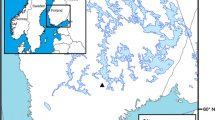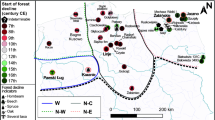Abstract
The threat of devastating pathogens on a range of tree species has increased recently, which justifies the investigation of the temporal dynamics of tree declines caused by disease. The mid-Holocene Elm Decline was a widespread and synchronous event recorded in pollen diagrams across northwest Europe. The probable drivers of this event have been debated for over 80 years but the role of disease has gathered greatest support in recent decades. Here we report pollen data at sub-decadal resolution from a closely sampled sediment core from eastern Ireland covering the last 160 years. This provides data on the structure and dynamics of the surrounding woodland before, during and after the outbreak of Dutch elm disease in the 1970s. A decline in elm was also recorded in the 1940s associated with an earlier, less virulent, outbreak of elm disease. The elm population recovered from the 1940s outbreak after 20 years but did not recover from the 1970s pandemic. The pollen data also facilitate the comparison of this disease-mediated decline with the mid-Holocene Elm Decline; the impact of human disturbance and disease resulted in different woodland compositions and the adjustment of the woodland in response to these factors was rapid. The impact of Dutch elm disease on this elm 1970s population was very similar to that recorded in the mid-Holocene Elm Decline in Britain and Ireland.



Similar content being viewed by others
References
Booth RK, Brewer S, Blaauw M, Minckley TA, Jackson ST (2012) Decomposing the mid-Holocene Tsuga decline in eastern North America. Ecology 93:1,841–1,852
Boyd IL, Freer-Smith PH, Gilligan CA, Godfray HCJ (2013) The consequence of tree pests and diseases for ecosystem services. Science 342:823–831. https://doi.org/10.1126/science.1235773
Brasier CM (1979) Dual origin of recent Dutch elm disease outbreaks in Europe. Nature 281:78–80. https://doi.org/10.1038/281078a0
Brasier CM (2000) Intercontinental spread and continuing evolution of the Dutch elm disease pathogens. In: Dunn C (ed) The elms: breeding, conservation and disease management. Springer, Boston, pp 61–72
Brewer S, Jackson ST, Williams JW (2012) Paleoecoinformatics: applying geohistorical data to ecological questions. Trends Ecol Evol 27:104–112. https://doi.org/10.1016/j.tree.2011.09.009
Caseldine C, Fyfe R (2006) A modelling approach to locating and characterising elm decline/landnam landscapes. Quat Sci Rev 25:632–644. https://doi.org/10.1016/j.quascirev.2005.07.015
Crushell P, Connolly A, Schouten M, Mitchell FJG (2008) The changing landscape of Clara Bog: the history of an Irish raised bog. Irish Geogr 41:89–111
Emborg J, Heilmann-Clausen J (2007) The structure of Suserup Skov, 2002. The first re-measurement of a long-term permanent plot study of forest dynamics started in 1992. Ecol Bull 52:19–32
Fægri K, Iversen J, Kaland PE, Krzywinski K (eds) (1989) Textbook of pollen analysis, 4th edn. Wiley, Chichester
Griffith R (1847) General valuation of Ireland, valuation of tenements rateable to poor rates. County of Dublin, Union of Balrothery, Barony of Nethercross. Alexander Thom, Dublin. http://www.askaboutireland.ie/griffith-valuation/. Accessed 25 Jan 2018
Griffith R (1848) General valuation of Ireland, valuation of tenements rateable to poor rates. County of Dublin, Union of Balrothery, Barony of Nethercross. Alexander Thom, Dublin. http://www.askaboutireland.ie/griffith-valuation/. Accessed 25 Jan 2018
Grimm E (2013) TILIA and TGView software. Springfield Museum, Illinois
Hirons KR, Edwards KJ (1986) Events at and around the first and second Ulmus declines: palaeoecological investigation in Co Tyrone, Northern Ireland. New Phytol 104:131–153
Huntley B, Birks HJB (1983) An atlas of past and present pollen maps for Europe: 0–13,000 years ago. Cambridge University Press, Cambridge
Kautz M, Meddens AJH, Hall RJ, Arneth A (2017) Biotic disturbances in Northern Hemisphere forests—a synthesis of recent data, uncertainties and implications for forest monitoring and modelling. Glob Ecol Biogeogr 26:533–552. https://doi.org/10.1111/geb.12558
Kent M (2012) Vegetation description and data analysis: a practical approach, 2nd edn. Wiley-Blackwell, Chichester
Kirby KJ, Goldberg EA, Isted R, Perry SC, Thomas RC (2016) Long-term changes in the tree and shrub layers of a British nature reserve and their relevance for woodland conservation management. J Nat Conserv 31:51–60. https://doi.org/10.1016/j.jnc.2016.03.004
Lamb H, Thompson A (2005) Unusual mid-Holocene abundance of Ulmus in western Ireland—human impact in the absence of a pathogen? Holocene 15:447–452
Liebhold AM, Brockerhoff EG, Kalisz S, Nuñez MA, Wardle DA, Wingfield MJ (2017) Biological invasions in forest ecosystems. Biol Invasions 19:3,437–3,458. https://doi.org/10.1007/s10530-017-1458-5
Mangan A, Walsh PF (1980) Some observations on the spread of Dutch elm disease in Ireland, 1978–79. Irish J Agric Res 19:133–140
McCune B, Mefford MJ (2011) PCORD. Multivariate analysis of ecological data version 6.08. MjM Software, Gleneden Beach
Mitchell FJG (2011) Exploring vegetation in the fourth dimension. Trends Ecol Evol 26:45–52. https://doi.org/10.1016/j.tree.2010.10.007
Mitchell FJG, Stefanini BS, Marchant R (2013) A catalogue of Irish pollen diagrams. Biol Environ (Proc R Ir Acad) 113B:103–135
Molloy K, O’Connell M (1987) The nature of the vegetational changes at about 5,000 bp with particular reference to the Elm Decline—fresh evidence from Connemara, western Ireland. New Phytol 106:203–220. https://doi.org/10.1111/j.1469-8137.1987.tb04894.x
Moore PD, Webb JA, Collinson ME (1991) Pollen analysis, 2nd edn. Blackwell, Oxford
O’Connell M (1980) The developmental history of Scragh Bog, Co. Westmeath and the vegetational history of its hinterland. New Phytol 85:301–319
OSI (2017) Ordnance Survey of Ireland MapViewer. http://map.geohive.ie/mapviewer.html. Accessed 15 Nov 2017
Parker AG, Goudie AS, Anderson DE, Robinson MA, Bonsall C (2002) A review of the mid-Holocene elm decline in the British Isles. Prog Phys Geogr 26:1–45. https://doi.org/10.1191/0309133302pp323ra
Parnell AC, Haslett J, Allen JRM, Buck CE, Huntley B (2008) A flexible approach to assessing synchroneity of past events using Bayesian reconstructions of sedimentation history. Quat Sci Rev 27:1,872–1,885. https://doi.org/10.1016/j.quascirev.2008.07.009
Peace T (1960) The status and development of elm disease in Britain. For Comm Bull 33:1–44
Peglar SM (1993) The mid-Holocene Ulmus decline at Diss Mere, Norfolk, UK: a year-by-year pollen stratigraphy from annual laminations. Holocene 3:1–13
Peglar SM, Birks HJB (1993) The mid-Holocene Ulmus fall at Diss Mere, South-East England—disease and human impact? Veget Hist Archaeobot 2:61–68. https://doi.org/10.1007/bf00202183
Perry I, Moore PD (1987) Dutch elm disease as an analogue of Neolithic elm decline. Nature 326:72–73. https://doi.org/10.1038/326072a0
Peterken GF, Mountford EP (1998) Long-term change in an unmanaged population of wych elm subjected to Dutch elm disease. J Ecol 86:205–218. https://doi.org/10.1046/j.1365-2745.1998.00255.x
Potter C (2015) Tree and forest pests and diseases: learning from the past to prepare for the future. In: Kirby KJ, Watkins C (eds) Europe’s changing woods and forests: from wildwood to managed landscapes. CABI, Wallingford, pp 337–346
Potter C, Urquhart J (2017) Tree disease and pest epidemics in the Anthropocene: a review of the drivers, impacts and policy responses in the UK. For Policy Econ 79:61–68. https://doi.org/10.1016/j.forpol.2016.06.024
Rackham O (1980) Ancient woodland: its history, vegetation and uses in England. Arnold, London
Reille M (1992) Pollen et spores d’Europe et d’Afrique du nord. Laboratoire de Botanique Historique et Palynologie, Marseille
Renberg I, Hansson H (2008) The HTH sediment corer. J Paleolimn 40:655–659. https://doi.org/10.1007/s10933-007-9188-9
Roberts N (2014) The Holocene: an environmental history, 3rd edn. Wiley, Chichester
Rose NL (1994) A note on further refinements to a procedure for the extraction of carbonaceous fly-ash particles from lake sediments. J Palaeolimnol 11:201–204
Rose NL, Appleby PG (2005) Regional applications of lake sediment dating by spheroidal carbonaceous particle analysis, United Kingdom. J Paleolimnol 34:349–361
Salehi MH, Hashemi Beni O, Beigi Harchegani H, Esfandiarpour Boruheni I, Motaghian HR (2011) Refining soil organic matter determination by Loss-on-Ignition. Pedosphere 21:473–482
Stockmarr J (1971) Tablets with spores used in absolute pollen analysis. Pollen Spores 13:615–621
West JC (1954) The Dutch elm disease. Summary of fifteen years hybridisation and selection work (1937–1952). Tijdschr Plantenziekten 60:109–127
Whitehouse NJ et al (2014) Neolithic agriculture on the European western frontier: the boom and bust of early farming in Ireland. J Archaeol Sci 51:181–205. https://doi.org/10.1016/j.jas.2013.08.009
Whittington G, Edwards KJ, Cundill PR (1991) Paleoecological investigations of multiple elm declines at a site in north Fife, Scotland. J Biogeogr 18:71–87. https://doi.org/10.2307/2845246
Willis KJ, Bailey RM, Bhagwat SA, Birks HJB (2010) Biodiversity baselines, thresholds and resilience: testing predictions and assumptions using palaeoecological data. Trends Ecol Evol 25:583–591
Acknowledgements
The authors wish to thank Hans Visser of Fingal County Council for facilitating access to the site and Aisling Holohan for assistance with field work. We also thank Andy Bielenberg and Matthew Kelly for providing information on the history of the site. We are also most grateful for the valuable comments from two anonymous referees and Michael O’Connell, which have improved the manuscript.
Author information
Authors and Affiliations
Corresponding author
Additional information
Communicated by M. O’Connell.
Electronic supplementary material
Below is the link to the electronic supplementary material.
Rights and permissions
About this article
Cite this article
Flynn, L.E., Mitchell, F.J.G. Comparison of a recent elm decline with the mid-Holocene Elm Decline. Veget Hist Archaeobot 28, 391–398 (2019). https://doi.org/10.1007/s00334-018-0698-3
Received:
Accepted:
Published:
Issue Date:
DOI: https://doi.org/10.1007/s00334-018-0698-3




